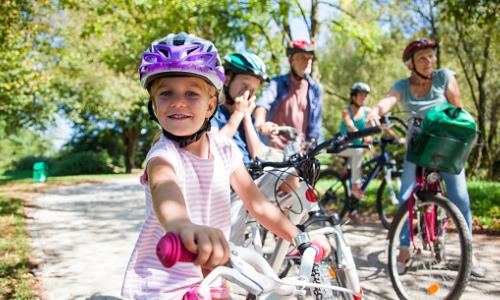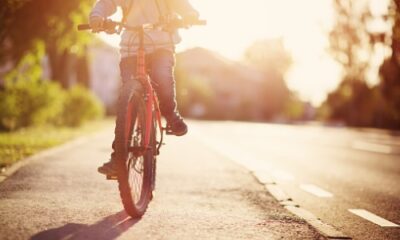For kids and kids at heart, bicycles are a fun way to travel and get some fresh air. But when you have to share the road with motorists, bicycles can lead to dangerous accidents and injuries.
As your kids grow more comfortable with their new wheels, teach them essential bicycle safety. Good habits for adult bicycle safety start young, so share these tips with your kids on your next family ride.
Bike safety for kids of all ages
Find the right fit
Helmets and bikes come in different sizes. Your kids’ next bike ride will be safer and more comfortable if their protective gear and bicycle fit them.
Bicycle helmet
Before buying a helmet, measure your child’s head all the way around. Find the fit closest to their head size and give it a try.
Take measurements in centimeters and inches because many bike helmets use metric measurements. You can also find half sizes in between if your child doesn’t fit any of the measurements below.1
Helmet size range:
- XXXXS: 18 inches or 46 centimeters
- XXS: 18.5 inches or 47 centimeters
- Size 6: 19 inches or 48.3 centimeters
- Size 7: 22 inches or 55.9 centimeters
- Size 8: 25 inches or 63.5 centimeters
The right bicycle helmet won’t wiggle on their head and should sit comfortably an inch above their eyebrows. They should be able to see the edge of the helmet they look up.
The best bike helmets for kids will have plenty of adjustment options to fit them as they grow, offer durable protection, and make your kids more visible to traffic around them.
Why are bicycle helmets important?
A bicycle crash can be caused by a pedestrian, parked car, potholes, or other hazards your child may not be aware of. So it’s always best to wear a helmet just in case.
Bike frame
The right bike frame for your child depends on their height.
A good fit will allow your kids to place both feet on the ground while sitting in the seat. When looking for a new bike, fix the seat on the lowest setting. As they grow, you can raise the seat until they outgrow the bike entirely.
Be seen
Even an experienced cyclist can face traffic accidents. An estimated 857 bicyclists were killed in 2018.3
If you and your kids ride anywhere near vehicles, teach them how to stay visible to drivers by wearing bright clothing and attaching reflectors to bikes.
Show them how to look both ways even when there aren’t cars around, and discourage them from riding after dusk.
Teach your kids to ride with traffic during the day and how to use the bike lane and crosswalk correctly. Encourage them to plan their routes and stick to bike lanes without swerving or confusing drivers.
Check your bike before leaving
Before your kids venture out, teach them to check their bike’s condition. Make sure the chain is healthy and tight, the seat is secure, and the tires have enough air.
Teach them basic bike maintenance like pumping the tires and adjusting the seat. If something doesn’t feel right on their bike, they should learn to get off before riding too far.
Bike safety tips for kids under 7
Keep your young bicyclists safe by riding with them. Make sure they stay within your sight and bike in safe areas like your neighborhood, parks, or paved pathways.
Avoid areas that require using a bike lane or riding on the street. Kids under 7 may be too small for drivers to see if they bike alone.
When riding with your kids, help them form good lifelong biking habits. Show them how to look both ways before crossing a street, driveway, alleyway, or anywhere cars may cross. Teach them how to follow traffic signals, signs, and ride on the right side of the road.

Bike safety tips for kids 8 to 13
As your kids get older, they’ll want to go on their own rides more and more. Send them off with older siblings or friends, and keep their rides limited to areas nearby like parks and your own neighborhood.
If they live near their school, they can ride to school and back as long as they wear their bike helmet, bright clothes, and sport reflectors on their bikes to stay visible to vehicles. Make bike safety fun by letting them pick their own bright or reflective clothing.
Consider giving them a smartwatch or adding a GPS tracker to their backpack or bike. These devices can help you keep in touch with them while they enjoy their freedom. And if they get lost, hurt, or have trouble with their bike, you can reach them.
Bike safety tips for kids 14 to 18
Once your kids are teenagers, they should be big enough to ride alone or supervise their younger siblings on rides together. By adolescence, they can ride their bike to school or a summer job.
But even careful kids can be at risk for accidents or injuries, so set boundaries for where they can and can’t go. For example, tell them to stay within a 10-mile radius or only ride during certain times.
And just like adults, teens need to follow basic bike safety rules and wear a bicycle helmet, use reflectors and lights, wear bright colors, and follow traffic rules.
Make sure they know how to use the bike lane and when to cross busy crosswalks for longer rides. Remind them that they can get off their bikes and walk across the street in cases where they don’t feel safe riding in a busy intersection.
And while your teen may be too old for GPS trackers, their bike isn’t immune to theft. Adding a tracker to their bike along with a bike lock can keep their ride safe from getting swiped and make it easier to find if there is trouble.
Register your bike
Sources
- Helmets.org, ”Bicycle Helmet Size Chart,” February 2019. Accessed August 24, 2020.
- SafeKids Worldwide, “Bike Safety.” Accessed August 24, 2020.
- National Highway Traffic Safety Administration, “Bicycle Safety.” Accessed August 13, 2020.
The post Bike Safety for Kids appeared first on SafeWise.
Aricle source here: Bike Safety for Kids

No comments:
Post a Comment